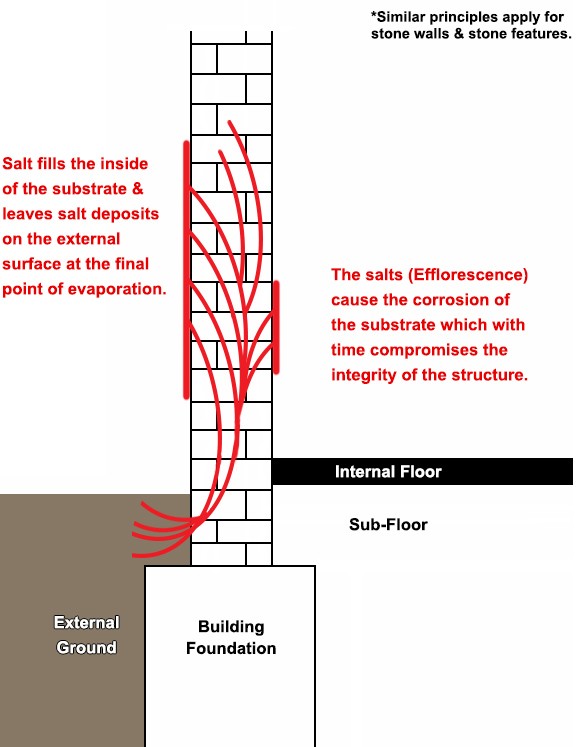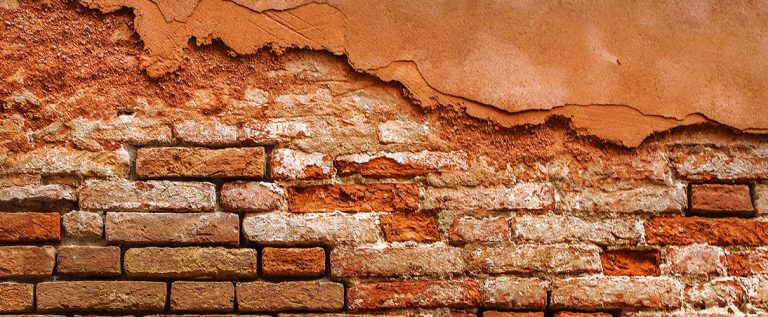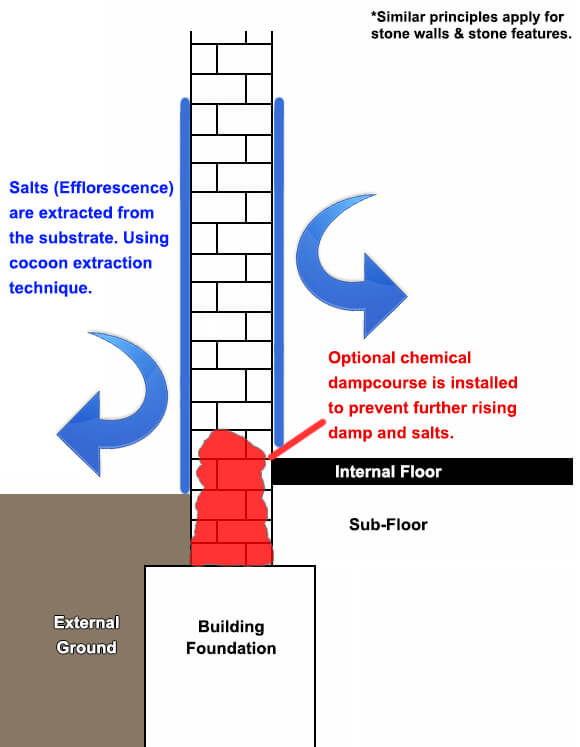
Spalling Brick Treatment - Efflorescence - Cocoon Salt Removal
Click To Call: 0474 499 309
(Ask for Jason)

Spalling Brick Treatment - Efflorescence - Cocoon Salt Removal
The Rising Damp Specialists
Ask For Jason: 0474 499 309
Efflorescence – Salt Removal – Cocoon – Spalling brick – Spalling Sandstone
Spalling Bricks & Sandstone Treatment. Salt Removal.

Cocoon Salt Extraction (efflorescence) From Spalling Sandstone
WITH SALT COMES DAMAGE
There are two different kinds of efflorescence.
- Efflorescence in ceramic tiles. i.e. balconies and walkways
- Efflorescence in masonry. i.e. Spalling & crumbling sandstone, bricks and other stones.
Efflorescence is when salt deposits on the surface of masonry like bricks, besser block, render and concrete. Often, rising damp and salt damage go hand in hand but not always.
To stop flaking & spalling, the salts need to be extracted from the brick or sandstone. There are a few methods for extracting salts from steam jetting with a vacuum cleaner chemical treatments and of course cocoon.
We have decided to use the cocoon system due to its low impact on the brickwork and sandstone and its superior salt removal.
One of the reasons we did not choose the steam system is because as the salts are diluted by the steam, the force of the steam can push some of the salts deeper into the masonry during the process. This means there may still be salts deeper in the substrate that could resurface in the future.
Chemical salt removal uses harsh substances (acids) which can cause damage to brick, sandstone and mortar. Not to mention if product is spilt accidentally during the work it could damage surrounding surfaces.

IMPORTANT THINGS TO KNOW
- Cocoon has been designed to remove salt from brickwork and sandstone to slow down spalling (not ceramic tiles).
- If your substrate is covered with paint, then the paint will need to be mechanically removed before the cocoon can be applied.
- Using a sealer on the surface of the masonry will not stop efflorescence. it will actually make the surface of the masonry glue together and the salt will gather just below the deepest point where the sealer had penetrated the masonry and gather there. As the salt crystallises behind the sealer the surface layer with the sealer will break away from the main body of the masonry and you will eventually peel the surface of the bricks/sandstone/blocks (that is held together by the sealer) off in SHEETS! **If someone has sealed your masonry in the past, we CAN get it off in a non-evasive way.
- Did you know that there are some kinds of salts that cannot be removed? In cases like these, the dampness and deterioration of the substrate can continue even after attempted salt extraction. We can do salt testing to determine the salt type and salt quantity in your substrate before we begin.
- If you live in an older area which has below ground walls and a sewer is leaking up the hill then you can have continuous salt entering your walls so even after the salt has been extracted, mineral loaded water can enter your walls during the next rain event.
- Rising damp is often the cause of salt damage (spalling) and in Sydney a lot of properties are close to salt water which can speed up the damage caused by salts from rising damp.
- Crumbling and spalling bricks are often very delicate. The cocoon process is a non pressurised system that can remove salt from crumbling bricks and sandstone using the physics of nature.

After Rising Damp Treatement Sometimes Cocoon is Needed
Cocoon
We extract the salt from deep within your walls by temporarily “cocooning” your wall in a special coating which “sucks” the salt out of your walls.
There are many methods that are used to treat efflorescence in walls and stone but none actually remove the salt from the substrate like the cocoon process does.
Any system that involves washing the wall with a pressure cleaner, applying acid or applying a sealer can push the salts back inside the wall which hides the effects until catastrophic spalling damage occurs.
Our system is environmentally friendly and uses cutting edge technology to draw the salts from your walls and stone features reducing the salt content in your walls to below 0.07% which is below erosive spalling levels.

What is Efflorescence/Spalling?
Efflorescence and spalling are caused by the accumulation of salt in a masonry substrate (like brick, sandstone or besser blocks) assisted by the capillary action of water. The salt moves through the inside the small pores of the substrate to the point where the moisture evaporates, as the salt dries it leaves the bricks or sandstone with the spalling effect of flaking, crumbling and dust.
How Does Efflorescence/Spalling Happen?
Each time moisture enters a masonry structure by capillary action the water transports diluted salts with it. As the walls dry, salt crystals grow.
Why Efflorescence/Spalling Bad?
The continual action of more salt crystals growing internally (within the pores of the masonry) pushes apart the structure of the bricks, blocks or stone from within. This process causes cumulative damage until finally the substrate is totally disintegrated leaving just grains of sand. Often people refer to the crumbling & flaking result as Brick Spalling. It can happen to brick, sandstone and besser block.
Crumbling Deteriorating Bricks
As salt dries within your bricks, salt crystals are formed. The salt generally crystallises at the surface of the bricks because that is the evaporation point of the moisture from your bricks.
Generally before removing salt from your bricks we recommend doing a series of salt percentage tests. This involves taking some dust from your bricks sending them to our lab to test the quantity of salt that is contained within them. Knowing the quantity of salt you have in your masonry before a cocoon process is initiated is important as it is a good gauge for how much had been extracted when a test is completed after the cocoon process is complete. i.e. before and after salt measurement comparisons.
If your bricks are crumbling, flaking and deteriorating (spalling) then give us a call and we can come and have a look at your sandstone or bricks to see if salt extraction process is suitable for you.
***We do not treat efflorescence in tiles. If you have efflorescence in your balcony or external walkway tiles, the only long lasting way to treat tiles for good is to remove your tiles and retile. After removing the old tiles and screed, apply waterproofing to the substrate before the new tile screed then apply a waterproofing membrane ON the new tile screed and retile. The membrane below the screed is your waterproofing barrier to protect your building, the membrane above the screed is a layer which prevents water entering the screed.
Efflorescence in tiled walkways and balconies is caused by water entering the screed below the tiles, this water dilutes the minerals inside the screed and when the sun heats the tiles, the water (which now contains the minerals from the screed) evaporates through the grout and the solids which are salts are left behind at the evaporation point at surface.
If you live near the ocean this problem can be much worse due to a much higher quantity of salt being in the air and covering the surface of your building. When it rains, all the salts which are on the surface are diluted and then go under your tiles. Again, when the sun heats up your tiles the water evaporates leaving salts at the evaporation point. If you live near the ocean you can still get efflorescence build-up on your tiled surfaces EVEN if the top of your screed has a waterproofing membrane simply because of the very high concentration of salt. It is always good to also use an efflorescence blocking additive in your screed.
If you use any kind of penetrating sealer to prevent water from entering your tiles then it needs to be maintained on a regular basis. Any transparent sealer breaks down very quickly in UV light so it is wise to reseal your tiles at least once a year. Regularity of sealing will depend on your situation. Sealing needs to start when the tiles are NEW and have just been laid. If your screed is already damp then sealing over a tiled area with a damp screed below will do nothing. The force that salt crystals exert as they grow is far beyond the strength of any sealer or waterproofing membrane. As salt crystallises it can turn 60MPA concrete into powder, if it can do this to 60MPA concrete then it will most definitely cause a transparent sealer to fail.
You can also use an epoxy grout to seal the grout joints better. We do not repair balconies and external walkways.
P.S. I can get pretty busy during the day so if you cant get through by phone then please use the form on this website (it’s a little easier for me to keep track of).
Location
Rising Damp Solutions Sydney
Spalling Brick Treatment
Eastern Suburbs
Lower Northern Beaches
Lower North Shore
Sydney Metro
Inner West
Concrete Slab Lifting
Our hours
07:00 – 18.00
Monday – Saturday
Contact us
Phone: 0474 499 309